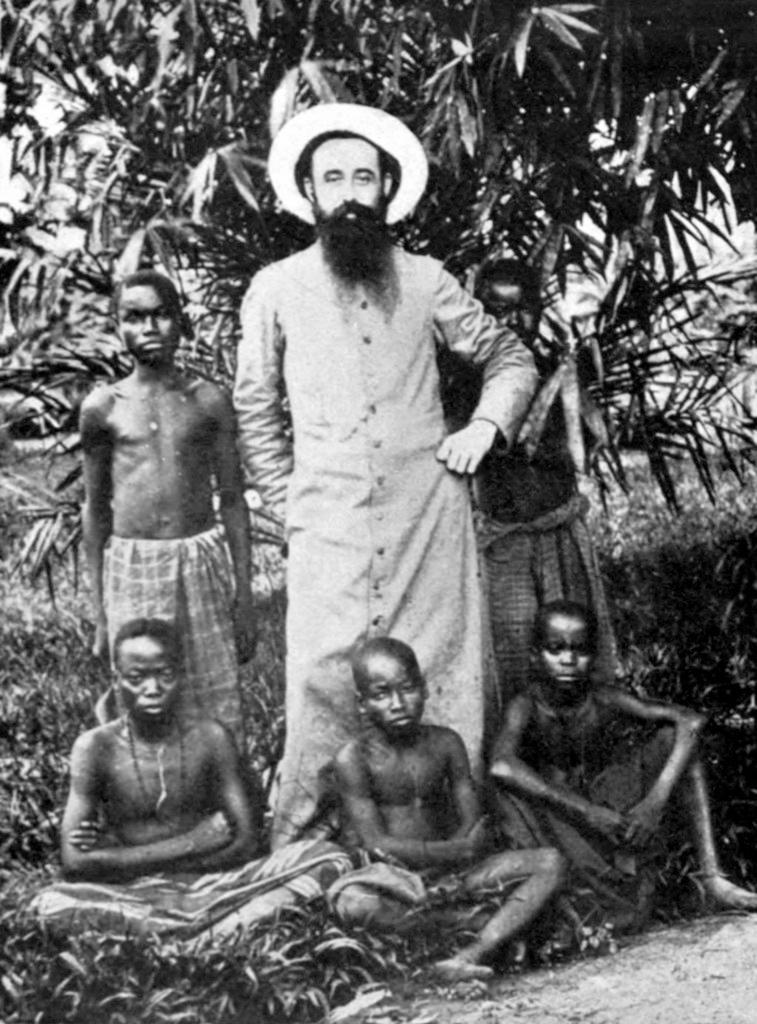
Congo Free State: Missionaries

Figure 1.-- This photograph shows a Catholic father with some Congolese boys. The photograph was taken about 1902. Many of the reports about colonial abuses came from the Protestant and not the Catholic missionaries who the King was able to effectively silence.
|
|
Missionaries througout Asia and Africa were both an element of colonial rule and governence as well as a force for tremendous good. Missionaries in the Congo were permitted only with the approval of Leopold's Congo Free State (CFS). He was able to keep the Belgian Catholic missionaries silent. This proved more difficult for other missionaries. British missionaries in particular compiled evidence of the terrible abuses. [Grant] Reports from missionaries proved to be some of the most compeling evidence against King Leopold's CFS. Witnessing a native killed, a Danish missionary wrote, "The soldier said 'Donít take this to heart so much. They kill us if we donít bring the rubber. The Commissioner has promised us if we have plenty of hands he will shorten our service.'" Eyewitness reports from missionaries such as those submitted by American William Henry Sheppard exposed terrible abuses. He was the son of a former slave. He managed to pursue a childhood dream of going to Africa as a missionary and in the process search for his identity. Sheppard attended Hampton College. The missionary reports came mostly from Protestant missiinaries. The King's spkesmen dismissed these reports as attempts by Protestants to smear honest Roman Catholic priests. King Leopold successfully supressed the truth for more than a decade. As the Kodak Brownie and similar camera made it possible for the missionaries to take photographs and send them out, this proved more difficult to do. The photographic evidence was material the King's spolesmen could not refute. And missionaries were located throughout the CFS to take and send out photographs.
Sources
Grant, Kevin. "Christian critics of empire: Missionaries, lantern lectures, and the Congo reform campaign in Britain," The Journal of Imperial and Commonwealth History Volume 29, Issue 2, (2001), pp. 27-58.
CIH

Navigate the Children in History Website :
[Return to Main Congo Free State page]
[Return to Main Belgian Congo history page]
[Return to Main Belgian Congo/Zaire history page]
[Return to Main National Empires in Africa page]
[Return to Main Scramble for Africa page]
[Return to Main Belgian regional page]
[About Us]
[Activities]
[Chronology]
[Clothing styles]
[Countries]
[Debate]
[Economics]
[Garment]
[Gender]
[Hair]
[History]
[Home trends]
[Literary characters]
[School types]
[Significance]
[Transport and travel
[Uniform regulations]
[Year level]
[Other topics]
[Images]
[Links]
[Registration]
[Tools]
[Return to the Historic Boys' School Home]
Created: 6:18 AM 2/3/2013
Last updated: 6:18 AM 2/3/2013



